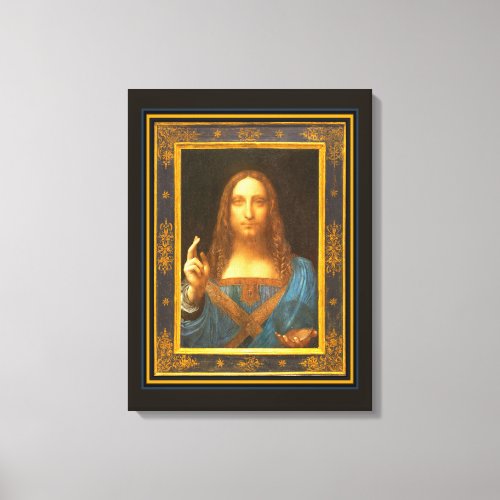Salvator Mundi c 1500 Leonardo da Vinci Canvas Print



Salvator Mundi c 1500 Leonardo da Vinci Fine Art Canvas Print ... Salvator Mundi 1500 by Renaissance genius and artist Leonardo da Vinci. Salvator Mundi is translated Saviour of the World in British English. Savior of the World in American English. Leonardo painted it about 1500 ... about 523 years ago! Owned by French kings ... then passing by marriage to English kings. Leonardo's wealthy patron for this work was none other than the French King Louis XII. Only the wealthiest art patrons could afford the expensive blue used on Christ's robe: finely crushed precious blue stone called lapis lazuli imported from Afghanistan ... sometimes found with some pure gold in it ... it was more expensive than pure gold. Leonardo's sfumato 'smoky' style was used here where he used the palm of his hand to blend away harsh edges to show atmospheric distance and here to give the effect of Christ appearing to Leonardo da Vinci out of darkness, His right hand raised in The Blessing, His left hand holding a crystal orb representing The World. Leonardo preferred to paint religious figures without halos ... such as in The Last Supper and The Madonna of the Rocks ... to show their humble human forms. Several parts of Salvator Mundi reflect the sketches and studies Leonardo had in his sketchbooks: the right hand raised in The Blessing, the eyes, the mouth, the curls in His hair, the intricate geometric pattern found in the cross strapping, the right sleeve cloth folds. The right hand is sharper because it is closer to the viewer. The full frontal portrait was standard for Salvator Mundis of the Renaissance painted by many artists ... Leonardo da Vinci's workshop of young apprentices produced several such Salvator Mundis from Leonardo's drawings (called cartoons) by poking holes through the artist's drawn lines and dusting them with charcoal to transfer the drawing to the white coated wood panel. The face was one such cartoon ... The Blessing hand another. Another Salvator Mundi from Leonardo's workshop is believed made from the same cartoons but with the face cartoon reversed and tilted a bit. Leonardo himself was far more scientific in thought than purely religious, but his wealthiest patrons who he had to please held their positions of wealth and power 'by the Grace of God', so Leonardo had to be careful not to offend them. He wore rose color it is said. He surrounded himself with younger handsome apprentices, some whom remained with him to his death. One such was Count Francesco Melzi to whom Leonardo willed his journals ... which Melzi organized and saved until his own death some 51 years after Leonardo's death. Young Francesco Melzi and Leonardo lived Leonardo's final three years at a home supplied by the French King Francis I connected by tunnel to the king's palace Amboise ... so the young King Francis I could regularly visit Leonardo da Vinci and Francesco Melzi there. Leonardo's patrons included the dukes of Florence (Medicis), the duke of Milan, two kings of France (Louis XII and young Francis I), and the Catholic Pope (another Medici). Another description: Leonardo da Vinci painted this Salvator Mundi c 1500 about 523 years ago ... his vision of Christ the Saviour of the World appearing to him out of darkness. He used rare crushed blue stone called Lapis Lazuli Ultramarine Blue for the robe, this paint was as expensive as pure gold and often had some pure gold in it. Only his most wealthy patrons could afford that such as French King Louis XII. French King Francis I provided elderly Leonardo with his final home at Clos Lucé adjacent to the French king's own Palace the Château d'Amboise which had a tunnel in between so the French King could privately visit Leonardo in his final days. Leonardo lived there with his assistant Count Francesco Melzi who Leonardo made his principle heir who inherited Leonardo's money, paintings, and notebooks. Leonardo also willed an earlier young male companion, Gian Giacomo Caprotti da Oreno, better known as Salaì, half of his vineyards. It has been written that Leonardo da Vinci was somewhat openly gay (for the antigay period) and liked to wear rose color garments and that he was therefore fortunate to have survived period (1494 - 1498) of 'the mad monk' Girolamo Savonarola in Florence who preached against such 'evils' until 1498 when he himself was hanged and consumed by fire after the Pope excommunicated him. Thankfully, Leonardo had been sent from the Florence court of the Medici to the court in Milan in 1482 which probably saved his life. Leonardo died at the French King Charles I's Clos Lucé at his Palace the Château d'Amboise in 1419. The Roman Catholic French Princess Henrietta Maria, daughter of Roman Catholic Marie de Medici and French King Henry IV took Leonardo's Salvator Mundi with her when she was married to the English King Charles VII in 1625. She survived his execution in 1649. Her sons Charles II and James II became Kings of England.


